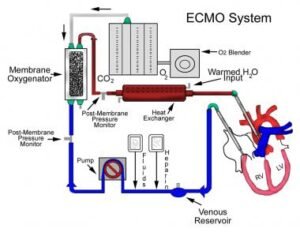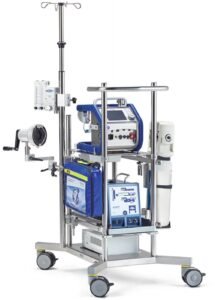Introduction
Extracorporeal Membrane Oxygenation (ECMO) is a life-saving technology used in critical care medicine to provide prolonged cardiac and respiratory support to patients whose heart and lungs are unable to function adequately. ECMO machines have become a cornerstone in the management of severe cardiopulmonary failure, offering a bridge to recovery or transplant for patients in dire situations. This article delves into the mechanics, applications, and considerations surrounding ECMO therapy.

What is an ECMO Machine?
An ECMO (Extracorporeal Membrane Oxygenation) machine is a complex medical device used in critical care settings to provide prolonged cardiac and respiratory support to patients whose heart and lungs are severely compromised. ECMO acts as an artificial heart and lung, allowing these organs to rest and heal while maintaining oxygenation and blood circulation in the body.
Types of ECMO Machine:
There are two primary types of ECMO
- Veno-Arterial (VA) ECMO: Provides both cardiac and respiratory support. Blood is drawn from a vein, oxygenated, and returned to an artery, effectively bypassing the heart and lungs.
- Veno-Venous (VV) ECMO: Provides respiratory support only. Blood is drawn from a vein, oxygenated, and returned to a vein, bypassing the lungs.
How ECMO Works
ECMO machines function by circulating blood outside the patient’s body through an artificial lung (the oxygenator), which removes carbon dioxide and adds oxygen, before returning the blood to the patient. This process allows the heart and lungs to rest and heal.
1.Cannulation: Large tubes called cannulas are inserted into the patient’s veins and arteries. These cannulas guide blood out of the body to the ECMO circuit.
2.Pump: The machine uses a pump to move blood through the circuit.
3.Oxygenator: Blood passes through an oxygenator, which adds oxygen and removes carbon dioxide, effectively performing the gas exchange normally carried out by the lungs.
4.Heat Exchanger: This component regulates the temperature of the blood to maintain the patient’s body temperature.
5.Return of Blood: The oxygenated blood is then returned to the patient’s body through the cannulas.
When is ECMO Used?
ECMO is typically used in severe cases of cardiac or respiratory failure unresponsive to conventional treatments. Common indications include:
- Acute respiratory distress syndrome (ARDS)
- Severe pneumonia
- Cardiac arrest
- Cardiogenic shock
- Transplants and surgeries :ECMO can help serve as a “bridge” until a person can get a specific type of care or procedure. Healthcare providers use ECMO for someone waiting for a heart or lung transplant or at these times:
- Transplant surgery.
- Heart and lung surgery.
- Recovery after surgery.
- Keeping an organ donor alive as long as possible.
- Infants and Newborns and infants with heart and lung problems, especially babies born prematurely, often receive ECMO treatment
 Components of ECMO Machine:
Components of ECMO Machine:
- Pump: Drives the blood through the circuit.
- Oxygenator: Serves as an artificial lung to oxygenate the blood and remove carbon dioxide.
- Heat Exchanger: Regulates the temperature of the blood.
- Cannulas: Tubes inserted into the blood vessels to allow blood to flow in and out of the body.
Operation
Administering ECMO is a complex process requiring a multidisciplinary team, including intensivists, cardiothoracic surgeons, perfusionists, and specialized nurses. The procedure begins with the insertion of large cannulas into the patient’s blood vessels. The ECMO machine then takes over the function of the heart and/or lungs, allowing these organs to rest and heal.
Patients on ECMO require intensive monitoring and management of anticoagulation to prevent clotting within the circuit. Regular assessments are conducted to evaluate organ function and determine the duration of ECMO support.
Technical specifications of ECMO Machine to help for the Procurement:-
The ECMO Machine should have Console system with Pump Drive Unit:
- The Pump Drive Unit should be centrifugal or diagonal pump.
- It should have integrated bubble sensor & a separate level sensor to monitor level.
- It should be supplied with Hand Crank or Backup Pump Drive Unit with backup battery pack for emergency used.
- Should have an adjustable arm assembly to hold its Drive Unit & also it should be able to fix it in any position.
- Should have battery backup for minimum 1.5 hours.
- Should have RPM speed 0-5000 rpm or above.
- Should have Flow Rate 0-8 litres per minute or above.
- It should have a warning Alert to the Operator that he has taken necessary clamp / valve to prevent back flow.
- Should be possible to set higher & lower limit for RPM along with low limit setting for LPM.
- It should have an integrated flow measuring sensor.
- In case of any error message, an acoustic alarm must be sound.
Oxygenator:
The Oxygenator should be CE certified for continuous used for minimum 14 days or more, for adult and Paediatric Applications.
Heating Cooling Unit:
Temperature setting range of water temperature should be 35 to 39 degree Centigrade or better with increments of 0.1 degree centrigrade.
Should have digital display for set & outlet temperature & should be capable of showing alarm indications.
Water reservoir capacity should not be more than 2-4 litres.
Miscellaneous:
Should have an advanced cart design maximizing safety and convenience to move the complete unit anywhere.
Should have a standard I.V. pole and provision for a second one.
Should have a convenient oxygen cylinder storage facility.
Gas Blender should be supplied with the ECMO unit
Other accessories should be supplied along with the ECMO Unit as below:
- Ultrasonic Gel
- Insertion kit
- Dilator
- Tubing Clamp
- Venous Canula (Femoral) one each: 17 FR, 19 FR, 21 FR, 23 FR, 25 FR
- Arterial Canula (Femoral) one each: 17 FR, 19 FR, 21 FR, 23 FR, 25 FR
Following are Consumables of the ECMO
- Complete Adult ECMO Patient Kit
- Complete Paediatric ECMO Patient Kit
- The patient Kits should content the below consumable Items
- Oxygenator for Adult and Paediatric
- PVC Tubing with Heparin+Albumin coated for Adult and Paediatric
- Pump-head with Heparin+Albumin coated for Adult and Paediatric
- Heat exchanger for Adult and Paediatric
- Any other consumables to make the system fully functional

Manufacturing Company of ECMO Machine:
- Getinge Group (Maquet Cardiopulmonary GmbH)
- Medtronic
- Sorin Group (LivaNova)
- Terumo
- ALung Technologies
- Xenios AG (Fresenius Medical Care):
Benefits and Risks
The primary benefit of ECMO is the potential to save lives in situations where traditional therapies have failed. It offers a critical bridge to recovery or further interventions, such as transplant surgery. However, ECMO is not without risks. Complications can include bleeding, infection, and mechanical failures of the ECMO circuit. Additionally, the need for anticoagulation increases the risk of hemorrhage.
ECMO machine not be used:
- When the person has or circulatory, Lung, heart problems that aren’t recover
- When the has savior damages of Brain, Liver
- When the person has cancer.
- Uncontrolled internal bleeding, especially in the head, or injuries that could lead to uncontrolled bleeding.
Advances and Innovations
Recent advancements in ECMO technology have improved its safety and efficacy. Innovations such as heparin-coated circuits reduce the risk of clotting, while portable ECMO systems allow for greater mobility and even transport of patients on ECMO. Research is ongoing to refine patient selection criteria, optimize management protocols, and expand the applications of ECMO in clinical practice.
Conclusion
ECMO represents a remarkable technological achievement in critical care medicine, offering hope and a chance for recovery to patients with severe cardiac and respiratory failure. While it carries significant risks and requires specialized expertise, the benefits it provides in life-threatening situations are profound. As technology and medical knowledge advance, ECMO continues to evolve, promising even greater potential to save lives in the future.
